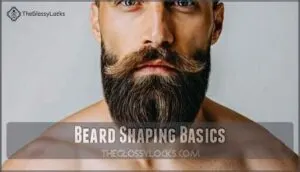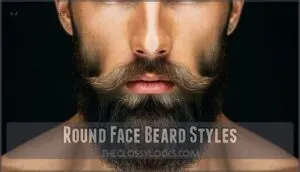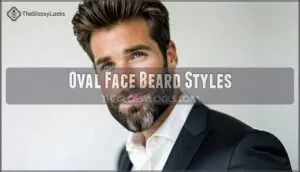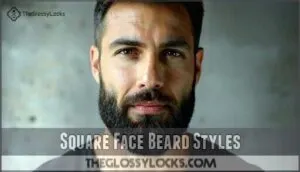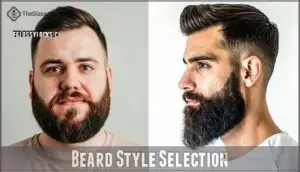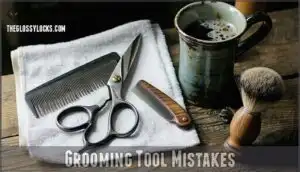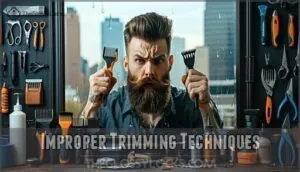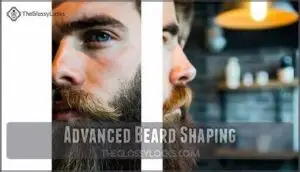This site is supported by our readers. We may earn a commission, at no cost to you, if you purchase through links.
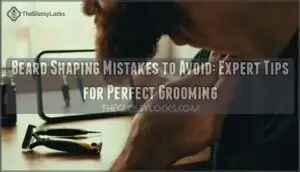
You’re likely trimming too much at once, ignoring your natural growth patterns, or choosing styles that clash with your face shape.
Don’t trim wet beards—they shrink when dry, leading to over-cutting.
Avoid using dull tools or regular scissors instead of proper beard trimmers.
Skip the temptation to "fix" small imperfections immediately; you’ll often make them worse.
Never trim against the grain or create harsh, unnatural lines.
Poor neckline placement ruins even well-groomed beards.
The biggest mistake? Rushing the process instead of working gradually with proper tools and techniques to achieve a well-groomed beard, and ultimately, rushing the process.
Table Of Contents
Key Takeaways
- Don’t trim wet beards – Wet hair appears longer and shrinks when dry, leading you to cut off more than intended and create uneven lengths
- Work with your natural growth patterns – Trimming against the grain or ignoring your hair’s natural direction creates irritation, uneven results, and harsh lines that look unnatural
- Choose beard styles that match your face shape – Round faces need length at the chin, square faces need softer edges, and ignoring your facial structure leads to unflattering results
- Trim gradually with quality tools – Taking off too much at once, using dull blades, or rushing the process creates mistakes that take weeks to fix
Common Beard Mistakes
You’re probably making at least one of these classic beard mistakes that can turn your carefully cultivated facial hair into a grooming disaster.
Whether it’s trimming too aggressively, choosing the wrong length for your face shape, or skipping essential maintenance steps, these common errors can sabotage even the most promising beard growth.
Trimming Errors
Most trimming mistakes happen when you’re too aggressive with your clipper.
Take your time with the clippers – rushing leads to weeks of regret.
Don’t rush the process or you’ll create uneven beard lines, necklines that sit too high, or cheek lines that drop too low.
These cutting errors require weeks to fix, so take your time and use proper lighting to avoid these common beard trimming errors, and trim conservatively.
Incorrect Beard Length
Getting the beard length wrong can sabotage your entire look.
You might grow it too long for your face shape or trim it too short, creating beard gaps and uneven edges.
Overgrowth issues make you look unkempt, while excessive trimming leaves patchy spots.
Finding your ideal beard length prevents these common beard shaping mistakes and guarantees balanced proportions.
Poor Maintenance Habits
Poor maintenance habits sabotage even the best beard styles, leaving you with a patchy, unkempt mess that screams negligence rather than sophistication.
- Irregular Trimming creates uneven lengths and destroys your beard’s natural shape over time
- Over Washing strips essential oils, causing dry skin and increased itchiness that ruins comfort
- Neglecting Beard Care products leads to split ends and brittle hair that breaks easily
- Ignoring Itch Management results in constant scratching that damages follicles and creates patchy spots
Beard Shaping Basics
Understanding beard shaping fundamentals will save you from costly grooming blunders that can take weeks to fix. You’ll need to master three core principles: working with your natural growth pattern, maintaining proper proportions, and using the right tools for each task.
Start by mapping your facial hair’s growth direction and density. Some areas grow faster than others, so you can’t treat your entire beard like a uniform lawn. Your neckline should sit about two fingers above your Adam’s apple, while your cheek line follows your natural growth boundary.
Quality beard trimming requires patience and the right grooming essentials. Use a reliable trimmer with multiple guard lengths, sharp scissors for precision work, and a fine-tooth comb to guide your cuts. Remember that facial hair design isn’t about copying someone else’s style – it’s about enhancing your unique features while avoiding common beard shaping pitfalls that leave you looking unkempt.
To achieve a polished look, consider mastering beard trimming techniques that suit your face shape and personal style. This approach will help you create a beard that complements your appearance and avoids common mistakes.
Face Shape Considerations
Your face shape determines which beard styles work best and which ones create unflattering proportions.
Choose a beard that works with your bone structure, not against it.
Choosing the wrong style for your facial structure can make your face appear wider, longer, or more angular than desired, and affect how well the beard style works.
Round Face Beard Styles
Round faces need strategic facial hair placement to create length and definition.
Focus your beard shaping for round face on elongating styles like Van Dyke or Ducktail beards that emphasize the chin area.
Avoid common beard shaping mistakes by keeping sides shorter while maintaining fuller beard length at the bottom.
This patchy beard fix creates angular lines that complement your face shape better than uniform chin straps or round styles.
To achieve the perfect look, consider exploring beard styles that add length and definition to round faces.
Oval Face Beard Styles
Oval faces can handle nearly any beard style without major beard shaping mistakes.
Your balanced proportions mean you won’t struggle with common face shape pitfalls.
Try everything from stubble to full beards – Van Dyke, Balbo, or beardstache styles all work beautifully.
Focus on beard trimming techniques that maintain your natural symmetry rather than fighting your face shape.
Square Face Beard Styles
Men with square faces often make the critical mistake of choosing beard styles that emphasize their already strong jawlines.
Face mapping reveals that square face beard styles should focus more hair on the chin while keeping sideburns shorter. This approach softens angular features and prevents your face from looking overly blocky.
- Grow fuller chin hair to elongate your face shape
- Keep beard trimming minimal on the sides and neck area
- Avoid chin straps that highlight your square jawline
- Choose jawline styles that add length rather than width
- Maintain a neat neckline to prevent a boxy appearance
Beard Length Mistakes
Getting your beard length right requires precision and restraint.
You’ll ruin months of growth with one overzealous trim, while letting sections grow wild creates an unbalanced, unkempt appearance that undermines your grooming efforts.
Over-Trimming
Over-trimming ranks as the top beard shaping mistake, with 63% of men trimming too frequently during growth phases.
You’ll lose essential weight and definition when rushing your trimming routine or using dull blades.
Wait 4-6 weeks before major shaping, use longer trimmer guards, and trim conservatively with frequent mirror checks to prevent cutting mistakes and achieve a better definition.
Under-Trimming
Under-trimming creates wild-beard syndrome where your facial hair becomes an unruly mess that overshadows your Facial Structure.
This beard shaping mistake occurs when you avoid Trimming Tools too long, allowing Hair Texture and Beard Density to work against you.
Signs you’re committing this beard trimming error:
- Stray whiskers poking out like tiny antennas from your cheek line
- Scraggly neckbeard creeping down your throat like ivy on a wall
- Overgrown mustache tickling your nose during every meal
Uneven Lengths
Nothing looks worse than irregular trimming that creates obvious length discrepancies across your facial hair.
These uneven edges scream amateur grooming and can turn even the thickest beard into a patchy mess.
When you rush through trimming or skip proper sectioning, you’ll end up with asymmetrical styles that highlight beard shaping mistakes rather than your best features, which can ultimately lead to a lack of proper sectioning.
Beard Style Selection
Selecting the wrong beard style for your face shape turns even the fullest facial hair into an unflattering mistake.
You’ll waste months of growth and grooming effort if you ignore your natural bone structure and hair growth patterns when choosing your beard style.
Choosing Wrong Style
Frequently choosing beard styles without considering your unique features leads to disappointing results.
Research shows 42% of men select styles randomly, ignoring face shape and hair texture compatibility.
Growth patterns and beard length requirements vary substantially between styles.
This beard shaping mistake wastes time and money while creating unflattering appearances that require costly professional corrections.
Ignoring Face Shape
Your face shape determines which beard styles will enhance or diminish your facial features.
Oval faces handle most styles well, while square faces need more chin hair and less side coverage.
Round faces require shorter sides with longer bottom growth for balance.
Ignoring your facial structure leads to poor beard symmetry and unflattering results that work against your natural jawline alignment, affecting your overall appearance and beard symmetry.
Not Considering Hair Type
Your hair texture and curl patterns directly impact which beard styles work best for you.
Coarse, curly hair creates natural volume but requires different shaping techniques than fine, straight hair that lies flat against your skin.
Dense follicle growth allows fuller styles, while sparse patterns need strategic trimming to avoid patchy appearances and common beard shaping mistakes.
Grooming Tool Mistakes
The right tools make perfect beard shaping possible, but the wrong ones can ruin months of growth.
You’ll damage your beard and waste time when you choose incorrect trimmers, misuse scissors, or brush improperly, which can be avoided by using the right tools correctly.
Using Wrong Trimmer
Selecting an inadequate trimmer transforms your grooming routine into a frustrating battle against uneven cuts and beard shaping mistakes. Low-power motors below 5000 RPM struggle with dense hair, causing snagging that leads to improper beard trim results.
Key Trimmer Selection Criteria:
- Motor Power – Choose trimmers with high-torque motors that handle thick, coarse beards without tugging or breaking hair strands
- Blade Quality – Invest in ceramic or sharp steel blades that maintain cutting angles and reduce split ends by 34%
- Adjustable Guards – Select models with transparent, variable-length attachments to prevent accidental short trims and symmetry issues
- Professional Features – Look for waterproof designs with contour edging capabilities that reduce trimming errors and improve safety precautions
When choosing a trimmer, consider the beard trimmer options available to find the best fit for your beard type and grooming needs.
Incorrect Scissor Usage
Beyond selecting the right trimmer, mastering scissor techniques prevents common cutting errors that ruin your beard’s appearance.
Improper scissor usage creates uneven lengths, damages hair texture, and leads to trimming mistakes that require weeks to correct.
To achieve professional results, for optimal outcomes, use high-quality beard scissors tools that are designed for precision and comfort.
| Common Mistake | Problem Created | Quick Fix |
|---|---|---|
| Cutting against hair growth | Jagged, uneven edges | Follow natural growth direction |
| Using dull blades | Split ends, frayed texture | Sharp, quality barber scissors only |
| Cutting too much at once | Patchy, over-trimmed areas | Take small snips gradually |
| Wrong angle cuts | Asymmetrical beard shape | Keep scissors parallel to face |
Improper Brushing Techniques
Why choose aggressive brush strokes when gentle detangling prevents hair breakage? Proper brush selection and technique eliminate beard tangles without damaging follicles.
Start at beard tips, working upward with short strokes rather than yanking through knots. Wrong brushing creates beard shaping mistakes that worsen uneven growth patterns.
These detangling tips transform your facial hair grooming routine, preventing common beard shaping errors and blunders. Using the right tools and techniques for beard split ends prevention can make a significant difference in maintaining a healthy beard.
Maintenance Mistakes
Even the best trimming technique won’t save your beard if you neglect regular maintenance. You can easily ruin months of careful growth with poor conditioning habits and inconsistent upkeep.
Infrequent Trimming
Skipping regular trimming sessions leads to overgrowth issues and uneven edges that destroy your beard’s shape.
Irregular cutting creates beard neglect problems, making your facial hair look unprofessional.
Establish a consistent beard trimming routine to prevent these beard shaping mistakes.
Weekly maintenance prevents beard maintenance issues and keeps your style sharp, avoiding the common beard shaping errors that ruin your look.
Insufficient Conditioning
When you skip regular conditioning, you’re setting yourself up for beard dryness and hair breakage that’ll turn your facial hair into a scratchy mess.
Without proper conditioning, your beard becomes prone to skin irritation and beard dandruff, creating itchiness that makes grooming a nightmare.
Conditioning prevents these beard maintenance issues by keeping hair soft and manageable for effective beard shaping.
Poor Beard Oil Application
Many men apply too much beard oil or skip essential areas when conditioning their facial hair.
Use just 3-5 drops for short beards and work the oil through damp hair from roots to tips.
Focus on your skin underneath and distribute evenly using your fingertips.
Over-oiling creates greasy, heavy hair that attracts dirt and looks unprofessional, which is why using the right amount is crucial for maintaining healthy and professional-looking facial hair.
Avoiding Patchy Beards
Patchy beards often result from rushing the growth process or trimming unevenly across different facial areas.
You’ll achieve better results by allowing natural growth patterns to develop and using consistent trimming techniques that work with your hair’s unique characteristics, which can lead to a more even and consistent look.
Uneven Growth Patterns
Your beard’s natural growth patterns create unavoidable irregularities that many men mistake for grooming failures.
Over 60% of men experience noticeable uneven growth due to genetics affecting follicle density across different facial zones.
Hair texture varies between cheek and chin areas, while growth rates differ substantially.
Facial asymmetry compounds these beard patches, making trimming techniques more challenging than expected.
Understanding proper beard growth phases is essential to addressing these uneven growth patterns effectively, considering the impact of facial asymmetry and the importance of recognizing natural growth patterns.
Improper Trimming Techniques
You’re sabotaging your beard when you rush the trimming process or use dull blades.
Wrong clipper settings create choppy layers, while cutting against the grain causes irritation and uneven results.
Poor edge control around your neckline and cheek borders ruins the entire shape.
Always trim with sharp tools, follow your natural growth direction, and work slowly for precise beard lines.
Lack of Patience
Growth happens slowly, not overnight. Your beard won’t transform into perfection with rushed trimming or impulsive decisions.
These premature cutting habits create permanent beard shaping mistakes that take months to fix.
The patience killers that ruin your progress:
- Hasty shaping – You grab clippers after two weeks, destroying potential
- Unrealistic expectations – You expect movie-star results without movie-star time
- Premature cutting – You panic at awkward growth phases instead of pushing through
Smart groomers follow beard shaping best practices: wait, watch, and resist those beard grooming fails.
Beard Care Errors
Your beard’s biggest enemies aren’t just bad trimmers or rushed mornings—they’re the everyday care mistakes that can turn even the best-shaped beard into a wiry, unhealthy mess.
The products you use and how you treat your facial hair make the difference between a beard that looks professionally groomed and one that screams neglect.
Using Regular Shampoo
Regular hair shampoo strips your beard of natural oils, disrupting its pH balance.
Hair Porosity differs between scalp and facial hair, requiring specialized formulas. Product Buildup from harsh detergents damages beard follicles.
Quality beard shampoo maintains Scalp Health while preventing common beard grooming fails in your beard care routine.
| Regular Shampoo Issues | Beard Shampoo Benefits |
|---|---|
| Strips natural oils | Preserves moisture balance |
| High alkaline pH (8-9) | Ideal beard pH (4.5-6.5) |
| Creates product buildup | Gentle, residue-free formula |
| Damages facial hair texture | Maintains beard softness |
Not Conditioning Enough
Your scalp shampoo strips away natural oils that your beard desperately needs.
Facial hair becomes dry, brittle, and prone to breakage without proper conditioning. This leads to split ends, itchiness, and dandruff that sabotage your grooming efforts.
Conditioning 2-3 times weekly prevents hair breakage and maintains healthy growth patterns essential for effective beard shaping.
Regular use of beard conditioning services can help achieve a healthier and more manageable beard, which is crucial for effective beard shaping.
Ignoring Beard Health
Many people unknowingly sabotage their beard’s potential by neglecting the fundamental health factors that support strong growth.
Your facial hair reflects your overall wellness, making proper nutrition and skincare essential components of effective beard maintenance.
Understanding the importance of beard health factors can substantially impact the quality of your beard.
- Beard Nutrition: Consume protein-rich foods and vitamins that nourish hair follicles from within
- Skin Care: Keep facial skin clean and moisturized to create ideal growing conditions
- Hair Follicles: Protect follicles through gentle cleansing and avoiding harsh chemicals or over-manipulation
- Beard Hygiene: Wash regularly with beard-specific products to prevent buildup and irritation
Advanced Beard Shaping
Once you’ve mastered basic trimming, advanced beard shaping requires precision techniques that separate amateur grooming from professional results.
You’ll need to understand how custom styling creates distinctive looks while avoiding common mistakes that can ruin months of careful growth, which is crucial for achieving professional results.
Precision Trimming Techniques
Moving beyond proper care products, mastering precision trimming techniques transforms your beard from amateur hour to barber-shop quality.
Start with facial mapping—identify your natural beard lines and mark reference points. Use proper cutting angles with slow, controlled strokes following hair growth direction. Edge control requires steady hands and quality trimming tools with sharp blades.
Investing in the right beard trimmers can substantially improve your overall grooming experience.
| Technique | Common Mistake | Pro Solution |
|---|---|---|
| Cheek Lines | Cutting too high/low | Follow natural growth boundary |
| Neck Lines | Razor-sharp edges | Soft fade below jawline |
| Length Control | Rapid, uneven strokes | Slow sectional trimming |
| Symmetry Check | Single-angle viewing | Multiple mirror positions |
| Final Details | Ignoring stray hairs | Precision scissor cleanup |
Professional beard shaping tips emphasize patience over speed. Beard shaping mistakes like rushing create lasting beard shaping blunders requiring weeks to correct.
Creating Custom Beard Styles
Creating Custom Beard Styles requires blending traditional techniques with personal flair.
Start by mapping your face shape against classic styles, then modify proportions to suit your features.
Consider your facial hair’s growth patterns and density when designing, and mix elements from different styles – perhaps a Van Dyke chin with modified sideburns.
Remember, custom shaping demands patience and gradual adjustments to avoid irreversible beard shaping mistakes.
Frequently Asked Questions (FAQs)
What is the rule 5 for beards?
Statistics show 30,000 beard hairs grow non-uniformly. Rule 5 states you must wash your beard regularly—at least weekly, more for fine hair—to prevent bacterial infections and follicle damage.
What is a mistake for beard trimming?
Trimming too much off the sides creates an unbalanced look that emphasizes your jawline poorly.
You’ll end up with a patchy, uneven appearance that’s difficult to fix without starting over completely.
Should I trim my beard when wet or dry?
Ever wonder when your beard looks its best for trimming?
You should always trim your beard when it’s completely dry.
Wet hair appears longer and can lead to cutting off more than intended, resulting in an uneven, shorter-than-desired beard length, because wet hair and uneven lengths are key considerations.
How often should I replace beard trimmer blades?
Replace your beard trimmer blades every 6-12 months with regular use.
Dull blades tug at hair, causing irritation and uneven cuts.
You’ll notice when they need replacing—your beard won’t look as crisp.
Can I use regular hair products on beards?
Don’t use regular hair products on your beard.
Facial hair is coarser and your face’s skin is more sensitive than your scalp.
Beard-specific shampoos, oils, and balms are formulated for this unique texture and skin type.
Whats the proper beard washing frequency?
You should wash your beard 2-3 times weekly with beard-specific shampoo. Daily washing strips natural oils, causing dryness and irritation. Adjust frequency based on lifestyle and skin type.
Should I trim against or with grain direction?
Though many believe you should always trim with the grain, you’ll actually get better results trimming against it for precision shaping.
Trim against the grain for clean lines and detailed work, with the grain for general maintenance and length reduction.
Conclusion
Like barbers wielding straight razors in medieval guildhalls, today’s beard enthusiasts need steady hands and proper technique.
Mastering these beard shaping mistakes to avoid requires patience and practice. Start with quality tools, work with your natural growth patterns, and trim gradually.
Don’t rush—small adjustments create better results than dramatic changes. Remember your face shape when selecting styles.
Regular maintenance prevents major corrections later. With consistent care and proper technique, you’ll achieve the polished beard you want.
- https://www.philips.co.uk/c-e/mens-grooming/facial-style/beard-styles/top-beard-styles-for-round-face-shapes.html
- https://www.giftedbarbers.com/how-to-choose-beard-styles-for-your-face
- https://thevou.com/blog/round-face-shape-men-beard-styles/
- https://uk.braun.com/en-gb/male-grooming/facial-hair-styles/face-shapes-and-beard-styles
- https://jessejimz.com/beard-styles-round-face/

